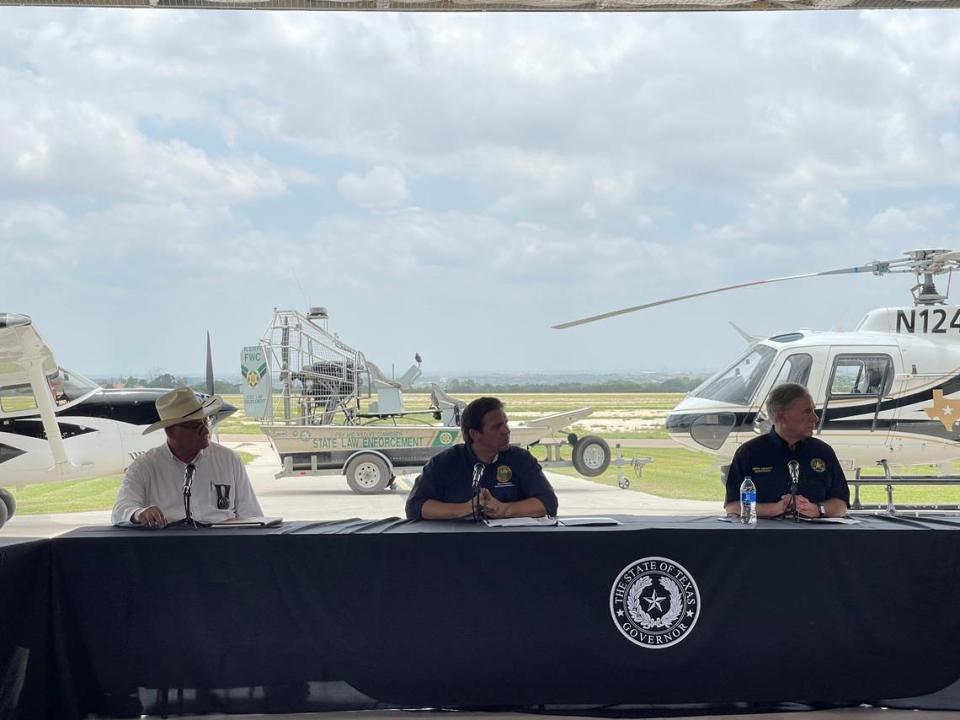DeSantis’ border mission cost at least $1.6M, an amount that is expected to rise
- Oops!Something went wrong.Please try again later.
Gov. Ron DeSantis over the summer sent dozens of Florida law enforcement officers and equipment to the southern border in Texas, and racked up a taxpayer-funded bill that so far amounts to at least $1.6 million but is expected to keep growing.
The seven-week trip, led by three state agencies, was cast by the Republican governor as a needed measure to beef up security at the border amid the failures of President Joe Biden’s administration, while critics saw the effort as a state-funded political errand used to further DeSantis’ national footprint ahead of a potential 2024 White House bid.
The Miami Herald reported earlier in November that the trip had cost taxpayers $570,988, but additional records released to the First Amendment Foundation and obtained by the Miami Herald show the actual cost was at least $1.6 million, a number that is still expected to grow.
The governor’s office did not correct the record when the Herald first asked about and later reported the $570,988 figure on Nov. 10, despite the actual cost of the mission being nearly triple that amount.
Instead, the governor’s office told the Herald at the time defended the smaller amount and said that “the cost of illegal immigration to Floridians are thousands of times more than $570,000.”
A ballooning figure
In reality, the $570,988 figure was only representative of the amount spent by the Florida Department of Law Enforcement, not the full cost of the mission. FDLE provided that figure to the Herald on Nov. 10, but records show the agency spent $20,000 more than what was initially disclosed.
When asked about the ballooning figures, the governor’s office and FDLE defended the cost and sidestepped questions about the incomplete disclosures.
“The cost of responding to the request for emergency assistance from Texas still pales in comparison to the enormous price Floridians pay for the Biden administration’s failure to secure the border and enforce our country’s immigration laws,” DeSantis’ spokeswoman, Christina Pushaw, said in a statement Tuesday morning.
While in Texas, state law enforcement officers made contact with 9,171 undocumented immigrants, Pushaw said. Just over 3% of those contacts resulted in a criminal arrest, according to data provided by Pushaw on Nov. 10.
FDLE spokeswoman Gretl Plessinger said the lower figure provided to the Herald reflected numbers that were “pulled in September and were accurate at the time.” The mission ended on Aug. 14.
“This is exactly the point of our public records law, to allow taxpayers and people who live in Florida to know how their dollars are being used, and what the government is doing with the dollars we give them,” said Pamela C. Marsh, the executive director of the First Amendment Foundation, which made the request for records detailing the costs of the mission.
The records outline a broad breakdown of how much was spent by the Florida Department of Law Enforcement, the Florida Fish and Wildlife Conservation Commission and the Florida Highway Patrol on supplies, travel, equipment, salaries, overtime pay, some fuel costs and other undisclosed expenses.
Missing from the records is how much the Florida Highway Patrol spent on fuel, a likely substantial cost because 114 troopers drove their vehicles from their respective counties in Florida to Del Rio, Texas, when deployed to patrol the area around the U.S.-Mexico border.
“What was explained to me was that they would need to figure out who was driving which car, when and then how much gas was put into each of those cars,” said Bob Shaw, a First Amendment Foundation board member who was told records detailing fuel costs from the agency would need to be collected separately.
FHP confirmed the 114 troopers from cities that include Miami, Orlando, Tampa, Jacksonville, West Palm Beach and Bradenton drove to Texas on two-week rotations.
No reimbursements
DeSantis’ office, and later FDLE, had said that the state agencies would be seeking reimbursements for all the expenses under the Emergency Management Assistance Compact, a partnership among all states to provide mutual aid.
In practice, Texas would have reimbursed Florida, because it had requested the assistance from Florida. But early on, Texas made clear it would not be reimbursing the state.
The Texas Department of Public Safety told the Herald/Times in July that there were no plans to reimburse Florida and that the state would be sending resources “at their own expense.”
So, the money will be coming out of the operating budgets of each state agency.
“No additional funds were received for this mission, all costs were funded through our legislative recurring operational budget,” states a spreadsheet compiled by FWC that noted that total cost to the agency was $618,086.
FWC spent the most out of all the three agencies. Its costs included $456,287 for payroll, most of which covered overtime pay; $100,000 for hotels, meals and other per diem; $39,444 for fuel, and $22,281 for other undisclosed expenses.
So far, FDLE has racked up a $591,848 bill to cover the salaries of dozens of state personnel, their travel costs, as well as supplies and equipment used during the border mission, records show. It is unclear whether the tally is final.
FHP spent $467,865 to send and pay 114 troopers to help at the border. Most of the expenses covered the state employees’ salaries, and $23,665 was spent on their travel. The fuel costs are not included in the travel expenses.
What was accomplished for $1.6 million?
According to Pushaw, state law enforcement officers had “contacts” with 9,171 undocumented migrants. That included:
▪ 311 criminal arrests
▪ 79 human smuggling cases
▪ 16 stolen vehicle cases
▪ 43 narcotics cases
▪ 4 drug seizures


